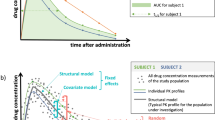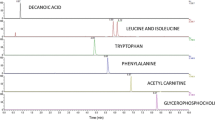Abstract
Special populations, like geriatric patients, experience altered paracetamol pharmacokinetics (PK), complicating pain management. More PK research is essential to optimize paracetamol (acetaminophen) dosing. Yet, the reference method ultra-performance liquid chromatography-tandem mass spectrometry (UPLC-MS/MS) is not readily available. Therefore, we aimed to evaluate the agreement between UPLC-MS/MS and the more accessible colorimetric Roche acetaminophen (ACETA) assay in quantifying paracetamol plasma concentrations, to facilitate PK studies and therapeutic drug monitoring for pain management. Patient data and plasma samples were obtained from a prospective study including geriatric patients admitted to the geriatric wards. ACETA and UPLC-MS/MS assays were performed in two separate laboratories. Bland–Altman plot and Passing-Bablok regression were used to assess agreement. Accuracy was evaluated using the McNemar test for a threshold value of 10 mg/L. Population PK modeling was employed to bridge PK data obtained from both methods (NONMEM 7.5). A total of 242 plasma sample pairs were available from 40 geriatric patients (age range, 80–95 years). Paracetamol plasma concentrations from ACETA (median 9.8 [interquartile range 6.1–14.4] mg/L) and UPLC-MS/MS (9.5 [6.2–14.8] mg/L) did not differ significantly (P > 0.05). No significant proportional nor additive bias was observed between both assay methods. The classification accuracy (at threshold 10 mg/L) was 85% (P = 0.414). The conversion factor between ACETA and UPLC-MS/MS was estimated at 1.06 (relative standard error 5%), yet with a 13.4% (relative standard error 23%) interindividual variability. ACETA assay showed no systematic bias in comparison with the UPLC-MS/MS assay in determining paracetamol exposure in geriatric blood samples despite the imprecision.
Graphical Abstract





Similar content being viewed by others
References
Gianni W, Madaio RA, Di Cioccio L, D’Amico F, Policicchio D, Postacchini D, et al. Prevalence of pain in elderly hospitalized patients. Arch Gerontol Geriatr. 2010;51(3):273–6.
Wu CL, Hung YL, Wang YR, Huang HM, Chang CH, Wu CC, et al. Pain prevalence in hospitalized patients at a tertiary academic medical center: exploring severe persistent pain. PLOS ONE. 2020;15(12):e0243574-e.
Deng LX, Patel K, Miaskowski C, Maravilla I, Schear S, Garrigues S, et al. Prevalence and characteristics of moderate to severe pain among hospitalized older adults. J Am Geriatr Soc. 2018;66(9):1744–51.
Soldato M, Liperoti R, Landi F, Finne-Sovery H, Carpenter I, Fialova D, et al. Non malignant daily pain and risk of disability among older adults in home care in Europe. Pain. 2007;129(3):304–10.
Arola HM, Nicholls E, Mallen C, Thomas E. Self-reported pain interference and symptoms of anxiety and depression in community-dwelling older adults: can a temporal relationship be determined? Eur J Pain. 2010;14(9):966–71.
Chen Q, Hayman LL, Shmerling RH, Bean JF, Leveille SG. Characteristics of chronic pain associated with sleep difficulty in older adults: the Maintenance of Balance, Independent Living, Intellect, and Zest in the Elderly (MOBILIZE) Boston Study. J Am Geriatr Soc. 2011;59(8):1385–92.
Bosley BN, Weiner DK, Rudy TE, Granieri E. Is chronic nonmalignant pain associated with decreased appetite in older adults? Preliminary evidence. J Am Geriatr Soc. 2004;52(2):247–51.
Karttunen N, Lihavainen K, Sipilä S, Rantanen T, Sulkava R, Hartikainen S. Musculoskeletal pain and use of analgesics in relation to mobility limitation among community-dwelling persons aged 75 years and older. Eur J Pain. 2012;16(1):140–9.
Leveille SG, Jones RN, Kiely DK, Hausdorff JM, Shmerling RH, Guralnik JM, et al. Chronic musculoskeletal pain and the occurrence of falls in an older population. JAMA. 2009;302(20):2214–21.
Ardoino I, Franchi C, Nobili A, Mannucci PM, Corli O, Pietrangelo A, et al. Pain and frailty in hospitalized older adults. Pain Ther. 2020;9(2):727–40.
Gibson SJ, Lussier D. Prevalence and relevance of pain in older persons. Pain Medicine. 2012;13(suppl_2):S23–6.
Abdulla A, Adams N, Bone M, Elliott AM, Gaffin J, Jones D, et al. Guidance on the management of pain in older people. Age and Ageing. 2013;42(suppl_1):i1–57.
American Geriatrics Society Panel on Pharmacological Management of Persistent Pain in Older Persons. Pharmacological management of persistent pain in older persons. J Am Geriatr Soc. 2009;57(8):1331–1346. https://doi.org/10.1111/j.1532-5415.2009.02376.x
Zentiva Pharma UK Limited. Paracetamol 500mg Tablets - Summary of Product Characteristics (SmPC) [Internet]. medicines.org.uk. 2023 Aug 10 [cited 2023 Sep 01]. Available from: https://www.medicines.org.uk/emc/product/5164/smpc
Bos JC, Mistício MC, Nunguiane G, Mathôt RAA, Van Hest RM, Prins JM. Paracetamol clinical dosing routine leads to paracetamol underexposure in an adult severely ill sub-Saharan African hospital population: a drug concentration measurement study. BMC Research Notes. 2017;10(1):671.
Mian P, Allegaert K, Spriet I, Tibboel D, Petrovic M. Paracetamol in older people: towards evidence-based dosing? Drugs Aging. 2018;35(7):603–24.
American Geriatrics Society Panel on Pharmacological Management of Persistent Pain in Older P. Pharmacological management of persistent pain in older persons. J Am Geriatr Soc. 2009;57(8):1331–46.
Mangoni AA, Jackson SHD. Age-related changes in pharmacokinetics and pharmacodynamics: basic principles and practical applications. Br J Clin Pharmacol. 2003;57(1):6–14.
Cairney DG, Beckwith HKS, Al-Hourani K, Eddleston M, Bateman DN, Dear JW. Plasma paracetamol concentration at hospital presentation has a dose-dependent relationship with liver injury despite prompt treatment with intravenous acetylcysteine. 2016;54(5):405–10. https://doi.org/10.3109/15563650.2016.1159309.
Manyike PT, Kharasch ED, Kalhorn TF, Slattery JT. Contribution of CYP2E1 and CYP3A to acetaminophen reactive metabolite formation. Clin Pharmacol Ther. 2000;67(3):275–82.
Rossi L, McGirr LG, Silva J, O’Brien PJ. The metabolism of N-acetyl-3,5-dimethyl-p-benzoquinone imine in isolated hepatocytes involves N-deacetylation. Mol Pharmacol. 1988;34(5):674–81.
Mitchell JR, Jollow DJ, Potter WZ, Gillette JR, Brodie BB. Acetaminophen-induced hepatic necrosis. IV. Protective role of glutathione. J Pharmacol Exp Ther. 1973;187(1):211–7.
Bruderer R, Bernhardt OM, Gandhi T, Miladinović SM, Cheng LY, Messner S, et al. Extending the limits of quantitative proteome profiling with data-independent acquisition and application to acetaminophen-treated three-dimensional liver microtissues. Molecular & cellular proteomics : MCP. 2015;14(5):1400–10.
Jaeschke H, McGill MR, Ramachandran A. Oxidant stress, mitochondria, and cell death mechanisms in drug-induced liver injury: lessons learned from acetaminophen hepatotoxicity. Drug Metab Rev. 2012;44(1):88–106.
Larson AM, Polson J, Fontana RJ, Davern TJ, Lalani E, Hynan LS, et al. Acetaminophen-induced acute liver failure: results of a United States multicenter, prospective study. Hepatology. 2005;42(6):1364–72.
Cooper SC, Aldridge RC, Shah T, Webb K, Nightingale P, Paris S, et al. Outcomes of liver transplantation for paracetamol (acetaminophen)-induced hepatic failure. Liver Transpl. 2009;15(10):1351–7.
Cieslak KP, Baur O, Verheij J, Bennink RJ, van Gulik TM. Liver function declines with increased age. HPB: The Official Journal of the International. Hepato Pancreato Biliary Association. 2016;18(8):691.
Herd B, Wynne H, Wright P, James O, Woodhouse K. The effect of age on glucuronidation and sulphation of paracetamol by human liver fractions. Br J Clin Pharmacol. 1991;32(6):768–70.
Erden-nal M, Sunal E, Kanbak G. Age-related changes in the glutathione redox system. Cell Biochem Funct. 2002;20(1):61–6.
Oldenburg LIK, Dalhoff KP, Sandoval LØ, Vermehren C. The risk of drug-drug interactions with paracetamol in a population of hospitalized geriatric patients. J Pharm. 2020;2020:1–9.
Hias J, Van der Linden L, Walgraeve K, Gijsen M, Mian P, Koch BCP, Allegaert K, Annaert P, Tournoy J, Spriet I. Pharmacokinetics of 2 oral paracetamol formulations in hospitalized octogenarians. Br J Clin Pharmacol. 2022;88(3):1020–30. https://doi.org/10.1111/bcp.15049.
Rumack BH, Matthew H. Acetaminophen poisoning and toxicity. Pediatrics. 1975;55:871–6.
Van Der Heijden LT, Mian P, Hias J, De Winter BCM, Tournoy J, Van Der Linden L, et al. Highly variable paracetamol pharmacokinetics after multiple oral dosing in frail older people: a population pharmacokinetic analysis. Drugs Aging. 2022;39(1):83–95.
Pharmacokinetic Study of Paracetamol in Patients Over 80 Years Hospitalized to an Acute Geriatric Ward. ClinicalTrials.gov Identifier: NCT03617471. Available from: https://clinicaltrials.gov/study/NCT03617471. Accessed 1 Sept 2023.
Diagnostics R. ACETA colorimetric assay. Mannheim; 2019
Delahaye L, Dhont E, De Cock P, De Paepe P, Stove CP. Dried blood microsamples: suitable as an alternative matrix for the quantification of paracetamol-protein adducts? Toxicol Lett. 2020;324:65–74.
Flint RB, Mian P, Van Der Nagel B, Slijkhuis N, Koch BCP. Quantification of acetaminophen and its metabolites in plasma using UPLC-MS: doors open to therapeutic drug monitoring in special patient populations. Ther Drug Monit. 2017;39(2):164–71.
Martin Bland J, Altman DG. Statistical methods for assessing agreement between two methods of clinical measurement. The Lancet. 1986;327(8476):307–10.
Passing H, Bablok W. A new biometrical procedure for testing the equality of measurements from two different analytical methods. Application of linear regression procedures for method comparison studies in clinical chemistry, Part I. Journal of clinical chemistry and clinical biochemistry. 1983;21(11):709–20.
McNemar Q. Note on the sampling error of the difference between correlated proportions or percentages. Psychometrika. 1947;12(2):153–7.
R Core Team. R: A language and environment for statistical computing. Vienna: R Foundation for Statistical Computing; 2021. https://www.R-project.org/
Team R. RStudio: Integrated Development for R. Boston, MA: RStudio, PBC; 2020.
Beal SL. J Pharmacokinet Pharmacodyn. 2001;28(5):481–504.
Savic RM, Karlsson MO. Importance of shrinkage in empirical bayes estimates for diagnostics: problems and solutions. AAPS J. 2009;11(3):558–69.
Lippi G, Salvagno GL, Montagnana M, Brocco G, Guidi GC. Influence of hemolysis on routine clinical chemistry testing. Clin Chem Lab Med. 2006;44(3):311–6.
Bertholf RL, Johannsen LM, Bazooband A, Mansouri V. False-positive acetaminophen results in a hyperbilirubinemic patient. Clin Chem. 2003;49(4):695–8.
Bergstrand M, Karlsson MO. Handling data below the limit of quantification in mixed effect models. AAPS J. 2009;11(2):371–80.
Acknowledgements
The resources and services used in this work were provided by the VSC (Flemish Supercomputer Center), funded by the Research Foundation—Flanders (FWO), and the Flemish Government.
Funding
This article receives no specific funding. AEE is supported by AGePOP, a Horizon 2020 research and innovation program; Marie Skłodowska-Curie grant (No. 956146).
Author information
Authors and Affiliations
Contributions
AEE, ED, JH, LVdL, IS, and JT made substantial contributions to the concept, design, and interpretation of data; JH, LVdL, IS, and JT collected the data; NVdE, SP, and BK performed the bioanalysis; AEE performed the data analysis and modeling and wrote the original draft; ED supervised the data analysis and modeling; KA, NVdE, SP, BK, ED, JH, LVdL, IS, and JT were involved in revising the manuscript critically for important intellectual content.
Corresponding author
Ethics declarations
Ethical Approval and Consent to Participate
All procedures performed in this study were in accordance with the ethical standards of the institutional research committee and with the Declaration of Helsinki and its later amendments. Informed consent was obtained from all individual participants involved in the study.
Conflict of Interest
The authors declare no competing interests.
Additional information
Publisher's Note
Springer Nature remains neutral with regard to jurisdictional claims in published maps and institutional affiliations.
Isabel Spriet and Jos Tournoy contributed equally to this work as senior authors.
Rights and permissions
Springer Nature or its licensor (e.g. a society or other partner) holds exclusive rights to this article under a publishing agreement with the author(s) or other rightsholder(s); author self-archiving of the accepted manuscript version of this article is solely governed by the terms of such publishing agreement and applicable law.
About this article
Cite this article
Edwina, A.E., Dreesen, E., Hias, J. et al. Agreement Between a Colorimetric Assay and Ultra-Performance Liquid Chromatography-Tandem Mass Spectrometry for Quantifying Paracetamol Plasma Concentrations. AAPS J 26, 23 (2024). https://doi.org/10.1208/s12248-024-00890-1
Received:
Accepted:
Published:
DOI: https://doi.org/10.1208/s12248-024-00890-1




